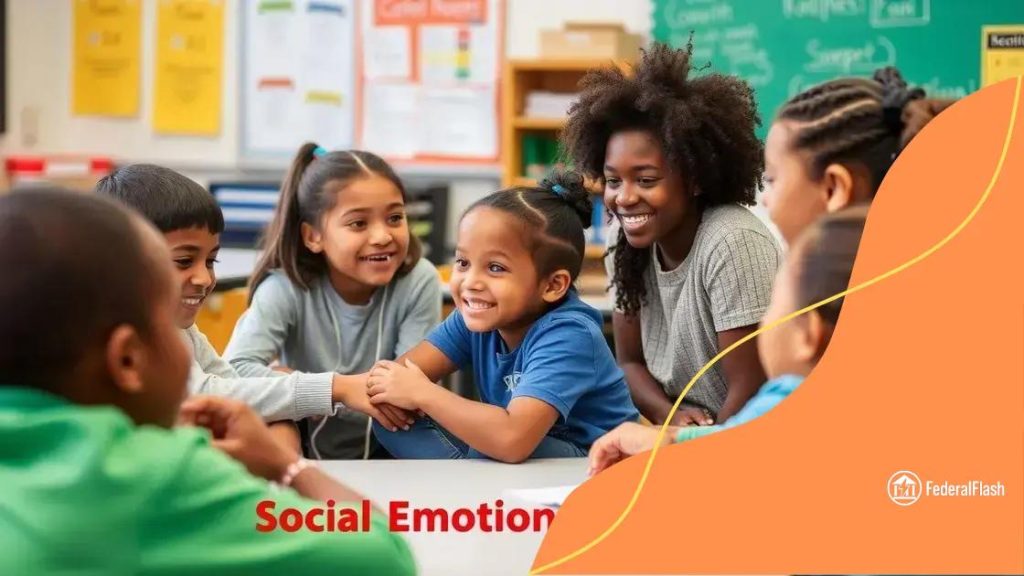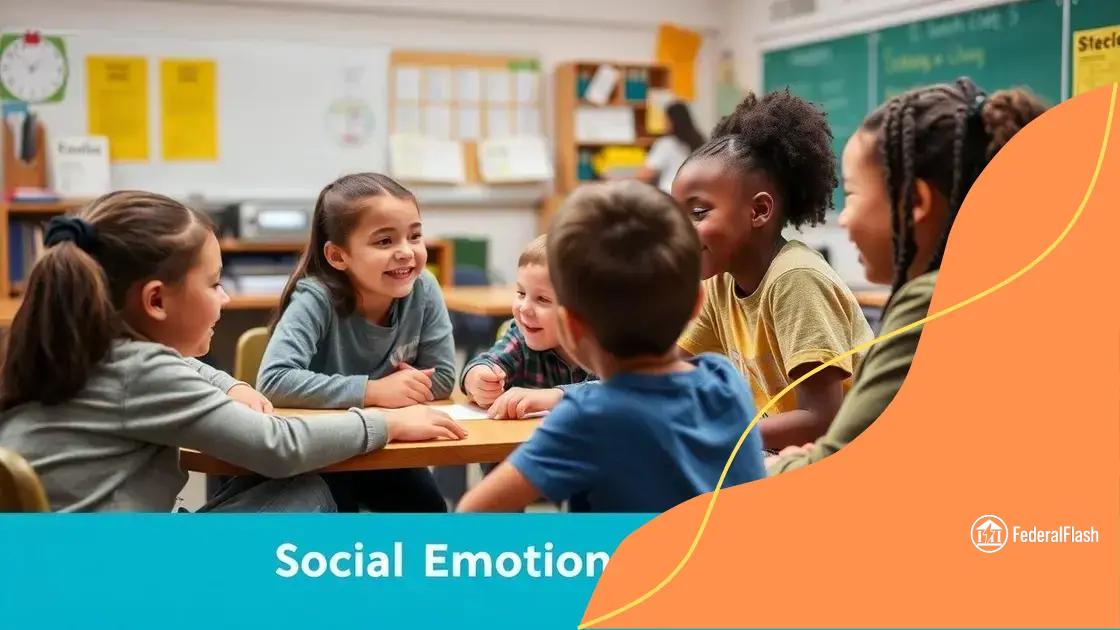The impact of social and emotional learning on academic outcomes

Anúncios
The impact of social and emotional learning (SEL) on academic outcomes is significant, as SEL promotes emotional regulation, enhances student engagement, and leads to improved grades and school culture.
The impact of social and emotional learning on academic outcomes is increasingly recognized as a vital area of focus for educators. Have you ever wondered how emotional skills affect student success? In this article, we’ll explore the intriguing connections between emotional intelligence and academic performance.
Anúncios
Understanding social and emotional learning
Understanding social and emotional learning (SEL) is crucial for creating a supportive educational environment. SEL helps students develop essential skills like empathy, self-regulation, and effective communication. These skills not only benefit personal interactions but also enhance academic performance.
What is social and emotional learning?
Social and emotional learning is a process that teaches students how to manage emotions, set goals, and build positive relationships. By incorporating SEL into the curriculum, educators can provide students with the tools they need for success both in school and life.
Key aspects of SEL include:
- Self-awareness: Understanding one’s own emotions and values.
- Self-management: Regulating emotions and behaviors effectively.
- Social awareness: Recognizing and respecting the perspectives of others.
- Relationship skills: Building healthy relationships through effective communication.
- Responsible decision-making: Making choices based on ethical considerations.
Integrating social and emotional learning into schools fosters a positive culture, making students feel more secure and engaged. This creates a powerful environment where learning can thrive. When students are emotionally supported, they are more likely to focus on their studies and contribute positively to their classrooms.
Anúncios
Furthermore, SEL encourages a sense of belonging among students. When individuals feel connected to their peers and teachers, they tend to have better social interactions. This ultimately leads to improved academic outcomes, as students are more willing to participate in class discussions and collaborate on projects.
In recent studies, schools that implement robust social and emotional learning programs show higher rates of student engagement and lower instances of misconduct. Additionally, these programs often lead to better mental health outcomes for students. As students learn to cope with stress and build resilience, their overall wellbeing improves, positively impacting their academic journey.
Key components of effective SEL programs
Key components of effective SEL programs are essential for ensuring that students can acquire the necessary skills for emotional and social success. These programs focus on various elements that support not just individual growth but also the collective environment of the classroom.
Essential components of successful SEL programs:
High-quality training for educators is crucial. Teachers must understand how to implement SEL principles effectively. When educators are trained, they are more likely to create a relatable and supportive atmosphere for their students.
- Continuous support for teachers: Regular feedback and resources help teachers integrate SEL into their daily routines.
- Engaging curriculum: Programs should include activities that are fun and relatable to students.
- Assessment tools: Evaluating students’ social and emotional skills helps in tracking progress.
Another important component is enabling student involvement. When students participate in their learning process, they are more invested in their development. This means incorporating student feedback and allowing them to voice their needs. In strong SEL programs, students feel that their opinions matter.
A focus on family engagement plays a vital role as well. Involving families in the lessons further reinforces the skills being taught. When parents and caregivers understand SEL principles, they can support their children’s emotional growth at home.
Building a safe and supportive environment
Creating a safe space for students to express their emotions is key for effective SEL. In this environment, students can share their feelings without fear of judgment. Teachers should encourage open discussions about emotions, allowing students to explore these topics together.
Furthermore, community partnerships enhance the effectiveness of SEL programs. Collaborating with local organizations can offer additional resources and expertise, providing students with opportunities to practice their skills in real-world settings. This connection helps bridge the gap between school and community, making learning more practical.
How SEL influences student performance

Understanding how social and emotional learning (SEL) influences student performance is crucial for educators and parents. SEL equips students with vital skills that improve not just their emotional well-being but also their academic success.
The connection between SEL and academic success
Students who engage in SEL programs tend to perform better in school. These programs teach students how to manage their emotions, set goals, and develop positive relationships. As a result, they are more focused, motivated, and ready to learn.
- Improved concentration: When students develop emotional regulation skills, they can concentrate more effectively in class.
- Higher grades: Numerous studies show that SEL participation correlates with improved grades.
- Better attendance: Students are more likely to attend school when they feel safe and supported socially.
In addition, SEL fosters resilience, enabling students to bounce back from setbacks. Each time a student overcomes a challenge, their confidence grows. This newfound confidence translates into a willingness to engage with harder subjects and take risks in their learning.
Moreover, SEL helps students build stronger relationships with peers and teachers. Good communication improves collaboration in group projects, leading to enhanced learning experiences. When students feel connected to others, they are less likely to exhibit behavioral issues that can disrupt learning.
Long-term benefits of SEL on student performance
Students who develop social and emotional skills often carry these lessons into adulthood. They are more likely to succeed professionally and personally. In fact, individuals equipped with strong SEL skills are likely to have better job performance and higher job satisfaction.
Many employers prioritize emotional intelligence in their hiring processes. This growing recognition indicates the lasting importance of SEL beyond the classroom and into future careers. Students who excel in SEL not only thrive in school but also pave the way for a brighter future.
Real-world success stories of SEL
Real-world success stories of social and emotional learning (SEL) illustrate its effectiveness in various educational settings. When implemented well, SEL programs can transform entire school cultures and improve student outcomes.
Case Study: A High School Reinvents Its Culture
One notable example comes from a high school that integrated SEL into its daily routine. By prioritizing emotional intelligence, the school experienced a substantial decrease in disciplinary issues. Teachers reported improved classroom dynamics, and students felt more connected, leading to better academic performance.
- Reduced conflicts among students.
- Increased student engagement during lessons.
- Higher graduation rates compared to previous years.
This high school’s transformation highlights how essential a positive school culture is for student success. When students felt safe and supported, they thrived both emotionally and academically.
Elementary School Pilot Program
Another inspiring story involves an elementary school that launched a pilot SEL program focusing on empathy and conflict resolution. This program taught students how to recognize their feelings and understand others’ emotions. As a result, the school saw noticeable changes.
Students became more skilled at resolving conflicts peacefully. They learned to express their emotions appropriately, resulting in a supportive environment. Classroom behavior improved significantly, and teachers found it easier to manage their classrooms.
After-School SEL Initiatives
Community organizations also play a role in spreading the message of social and emotional learning. One after-school program introduced SEL principles by encouraging teamwork and communication through various activities.
Kids participating in these programs learned valuable lessons about collaboration and respect. Feedback from parents indicated that students displayed more empathy and improved decision-making skills at home. Many parents observed positive changes in their children’s behavior and attitude.
These real-world success stories emphasize that SEL is not just a trend but a vital practice that benefits students, teachers, and the broader community.
Strategies for implementing SEL in schools
Implementing social and emotional learning (SEL) in schools requires thoughtful strategies to ensure effectiveness. When educators develop a clear plan, students benefit from valuable skills that last a lifetime.
Start with teacher training
One of the first steps is to provide comprehensive training for teachers. It is crucial that educators understand SEL principles and how to integrate them into their lessons effectively. Professional development sessions can help teachers feel more confident in using SEL techniques in their classrooms.
- Workshops on emotional intelligence and classroom management.
- Collaborative planning sessions for sharing best practices.
- Ongoing support through mentoring and resources.
Once teachers feel adequately prepared, they can start implementing SEL in their daily routines. This doesn’t mean all lessons need to focus solely on SEL; rather, it can be woven into existing subjects and activities.
Create a supportive environment
A supportive school culture is another important strategy. When students feel safe and accepted, they are more likely to embrace SEL concepts. Schools can promote inclusivity by celebrating diversity and encouraging respectful interactions.
Additionally, establishing clear expectations for behavior can greatly influence how students engage with each other. By setting guidelines that encourage empathy and respect, schools create a foundation for positive interactions.
Engage families and the community
Another effective approach is to involve families and community members. Schools can host events that educate parents about SEL. When families understand the importance of emotional and social skills, they can reinforce these lessons at home.
Partnering with local organizations can also enhance SEL programs. Community resources can provide additional support and create opportunities for students to practice their skills in real-world scenarios.
Overall, implementing SEL is a collaborative effort. Educators, parents, and the community must work together to create a positive atmosphere where students can thrive.
FAQ – Frequently Asked Questions about Social and Emotional Learning (SEL)
What is social and emotional learning (SEL)?
SEL is a process that helps students develop essential skills like emotional regulation, empathy, and effective communication.
How does SEL benefit students academically?
Students engaged in SEL programs tend to have improved grades, better attendance, and enhanced focus in the classroom.
What role do teachers play in implementing SEL?
Teachers are crucial in integrating SEL into the curriculum by receiving training and support to foster a positive and supportive learning environment.
Can families contribute to SEL initiatives?
Yes, involving families in SEL enhances its effectiveness, allowing parents to reinforce social and emotional skills at home.